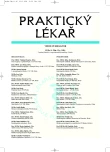Can Helicobacter pylori be one of the etiological factors of oropharyngeal carcinogenesis?
Může být Helicobacter pylori jedním z etiologických faktorů při vzniku nádorů orofaryngu?
Helicobacter pylori (dále HP) je známým patogenem především v žaludku, a je nejčastěji se vyskytující infekcí v populaci. V literatuře je udáván přímý vztah infekce HP a chronické gastritidy, vředové choroby, žaludečního adenokarcinomu, MALT lymfomu, ale i dalších onemocnění. V poslední době bylo publikováno několik prací zabývajících se vztahem HP a onemocnění dutiny ústní. Oblast orofaryngu může být vystavena působení HP cestou gastroezofageálního refluxu. Předpokládá se, že infekce HP zde může vyvolávat obdobné imunitní změny jako v žaludku, a tím přispívat k rozvoji různých patologií. HP je schopen ovlivnit produkci různých cytokinů a regulačních molekul, které mohou působit při rozvoji nádorového onemocnění (např. spinocelulárního karcinomu) orofaryngu. Několik studií prokázalo přítomnost HP v zubním plaku. Jen ojedinělé studie zkoumaly přítomnost HP v tonzilách, kde se podobně jako v žaludku jedná o lymfatickou tkáň vázanou na sliznici (MALT). Tyto studie přinesly rozporuplné výsledky. Otázkou zůstává, zda může HP přežívat ve tkání patrových tonzil a zda se zde účastní rozvoje patologických procesů.
Klíčová slova:
Helicobacter pylori, spinocelulární karcinom, NO syntázy, epitelový růstový faktor - EGF, transformující růstový faktor - TGF
Authors:
P. Lukeš 1; J. Astl 1; I. Šterzl 2; B. Potužníková 2; D. Veselý 1; J. Betka 1
Authors‘ workplace:
Klinika ORL a chirurgie hlavy a krku 1. LF UK, FN v Motole a katedra IPVZ Přednosta: Prof. MUDr. Jan Betka, DrSc.
1; Ústav imunologie a mikrobiologie 1 . LF UK a VFN Přednosta:
2
Published in:
Prakt. Lék. 2006; 86(11): 627-630
Category:
Reviews
Overview
Helicobacter pylori (HP) is a well known gastric pathogen. It plays a major role in the pathogenesis of chronic gastritis, duodenal and gastric ulcers, adenocarcinoma, gastric MALT lymphoma and a number of other diseases. HP infection is the most common bacterial infection worldwide. Recent studies have explored the relationship between HP and the oral cavity. The upper aerodigestive tract could be directly exposed to the bacterium by gastroesophageal reflux (GER). It is supposed that HP infection could cause the same immunological changes in the oropharyngeal mucosa as in gastric mucosa, and contribute to the progression of oropharyngeal diseases. HP can induce the production of different cytokines and regulatory molecules, which could promote carcinogenesis (e.g. spinocellular carcinoma) of the oropharynx. Some studies have confirmed presence of HP in dental plaque. Only a few studies have explored the presence of HP in tonsilar tissue, where mucosa associated lymphatic tissue (MALT) is present similarly as in gastric mucosa. The results of these studies were inconsistent. The question of persistence of HP in tonsilar tissue and its role in the pathogenesis of oropharyngeal diseases still remains unclear.
Key words:
Helicobacter pylori, spinocellular carcinoma, NO synthase, Epithelial Growth Factor – EGF, Transforming Growth Factor –TGF
Labels
General practitioner for children and adolescents General practitioner for adultsArticle was published in
General Practitioner

2006 Issue 11
- Metamizole vs. Tramadol in Postoperative Analgesia
- Memantine in Dementia Therapy – Current Findings and Possible Future Applications
- Metamizole at a Glance and in Practice – Effective Non-Opioid Analgesic for All Ages
- What Effect Can Be Expected from Limosilactobacillus reuteri in Mucositis and Peri-Implantitis?
- Metamizole in perioperative treatment in children under 14 years – results of a questionnaire survey from practice
Most read in this issue
- Experience in the treatment of torpid condylomata acuminata by 5% imiquimod cream
- Anaemia in chronic heart failure
- Indications of allogeneic and autologous haematopoietic cells transplantation – Recommendations of the Czech Society of Haematology and Czech Society of Oncology of the J. E. Purkyně Czech Medical Association.
- Valganciclovir in the pre-emptive treatment of cytomegalovirus infections following allogeneic stem cell transplantation.
